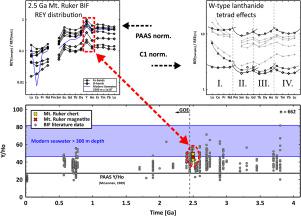当前位置:
X-MOL 学术
›
Gondwana Res.
›
论文详情
Our official English website, www.x-mol.net, welcomes your
feedback! (Note: you will need to create a separate account there.)
Banded iron formation from Antarctica: The 2.5 Ga old Mt. Ruker BIF and the antiquity of lanthanide tetrad effect and super-chondritic Y/Ho ratio in seawater
Gondwana Research ( IF 7.2 ) Pub Date : 2021-03-01 , DOI: 10.1016/j.gr.2020.11.011 David M. Ernst , Michael Bau
Gondwana Research ( IF 7.2 ) Pub Date : 2021-03-01 , DOI: 10.1016/j.gr.2020.11.011 David M. Ernst , Michael Bau

|
Abstract Here we report the first detailed geochemical data for Banded Iron-Formation (BIF) from Antarctica. Micro drill cores were taken from adjacent magnetite/haematite and metachert bands from the 2.5 Ga old Mt. Ruker BIF, Prince Charles Mountains, East Antarctica. Low concentrations of Al, Zr, Hf, and Sc reveal the purity of the samples. The chemical composition matches closely that of other early Precambrian BIF, except for an enrichment of Ni, and high Ba/Sr ratios in the metachert. Shale-normalized Rare Earths and Yttrium (REYSN) patterns show all the features of modern seawater such as depletion of light vs heavy REY, positive anomalies of LaSN, EuSN, GdSN, and YSN (i.e. super-chondritic Y/Ho ratios) and the W-type lanthanide tetrad effect (LTE), but no CeSN anomalies (and no positive Eu anomalies in chondrite-normalized REY patterns). This distribution is fully compatible with that of other pure Early Precambrian BIFs, suggesting high-temperature hydrothermal input of REY into seawater and a redox level of the atmosphere-hydrosphere system too reducing for Ce oxidation. The uniform, super-chondritic Y/Ho ratios in adjacent iron-oxide and metachert BIF bands most strongly suggest that the conspicuous banding does not result from post-depositional separation of an initially homogenous Fe-silicate precipitate, but argues for a primary origin of the banding. The super-chondritic Y/Ho ratios fit well within the range reported for other BIF worldwide, corroborating that positive Y anomalies, although possibly of smaller size than today, have always been a characteristic feature of seawater. The Mt. Ruker BIF further complements the set of Early Precambrian marine chemical sediments in which the W-type LTE has been observed, and demonstrates the antiquity of the LTE in seawater. These subtle features reveal that the distribution of the redox-insensitive REY in seawater did not change significantly over the almost 4 billion years geological record of seawater. The super-chondritic Y/Ho ratios and W-type LTE in this and other oxide-facies BIF are in marked contrast to the REY distribution in Modern and Cenozoic oxidic hydrogenetic ferromanganese crusts, pointing towards fundamentally different removal mechanisms of REY from Modern vs Early Precambrian seawater.
中文翻译:

来自南极洲的带状铁形成:2.5 Ga 古老的山。Ruker BIF 和远古的镧系元素四分体效应和海水中超球粒陨石 Y/Ho 比
摘要 在这里,我们报告了南极洲带状铁层 (BIF) 的第一个详细地球化学数据。微钻芯取自相邻的磁铁矿/赤铁矿和来自 2.5 Ga 老山的变质岩带。Ruker BIF,查尔斯王子山脉,南极洲东部。低浓度的 Al、Zr、Hf 和 Sc 揭示了样品的纯度。化学成分与其他早期前寒武纪 BIF 的化学成分非常匹配,除了 Ni 的富集和 metachert 中的高 Ba/Sr 比率。页岩归一化稀土和钇 (REYSN) 模式显示了现代海水的所有特征,例如轻与重 REY 的消耗,LaSN、EuSN、GdSN 和 YSN(即超球粒陨石 Y/Ho 比率)的正异常以及W 型镧系元素四分体效应 (LTE),但没有 CeSN 异常(球粒陨石归一化 REY 模式中没有正 Eu 异常)。这种分布与其他纯早前寒武纪 BIF 的分布完全兼容,这表明 REY 进入海水的高温热液输入和大气 - 水圈系统的氧化还原水平对于 Ce 氧化来说太低了。相邻的氧化铁和 metachert BIF 带中均匀的超球粒状 Y/Ho 比率最强烈地表明显着的带不是由最初均质的 Fe-硅酸盐沉淀物的沉积后分离引起的,而是争论的主要起源条带。超球粒陨石 Y/Ho 比值与全球其他 BIF 报告的范围非常吻合,证实了正 Y 异常,尽管可能比今天的尺寸小,但一直是海水的一个特征。山 Ruker BIF 进一步补充了已观察到 W 型 LTE 的早前寒武纪海洋化学沉积物,并证明了 LTE 在海水中的古老性。这些微妙的特征表明,在近 40 亿年的海水地质记录中,对氧化还原不敏感的 REY 在海水中的分布没有显着变化。这种和其他氧化物相 BIF 中的超球粒陨石 Y/Ho 比和 W 型 LTE 与现代和新生代氧化氢化铁锰结壳中的 REY 分布形成鲜明对比,表明现代与早期 REY 的去除机制完全不同前寒武纪海水。这些微妙的特征表明,在近 40 亿年的海水地质记录中,对氧化还原不敏感的 REY 在海水中的分布没有显着变化。这种和其他氧化物相 BIF 中的超球粒陨石 Y/Ho 比和 W 型 LTE 与现代和新生代氧化氢化铁锰结壳中的 REY 分布形成鲜明对比,表明现代与早期 REY 的去除机制完全不同前寒武纪海水。这些微妙的特征表明,在近 40 亿年的海水地质记录中,对氧化还原不敏感的 REY 在海水中的分布没有显着变化。这种和其他氧化物相 BIF 中的超球粒陨石 Y/Ho 比和 W 型 LTE 与现代和新生代氧化氢化铁锰结壳中的 REY 分布形成鲜明对比,表明现代与早期 REY 的去除机制完全不同前寒武纪海水。
更新日期:2021-03-01
中文翻译:

来自南极洲的带状铁形成:2.5 Ga 古老的山。Ruker BIF 和远古的镧系元素四分体效应和海水中超球粒陨石 Y/Ho 比
摘要 在这里,我们报告了南极洲带状铁层 (BIF) 的第一个详细地球化学数据。微钻芯取自相邻的磁铁矿/赤铁矿和来自 2.5 Ga 老山的变质岩带。Ruker BIF,查尔斯王子山脉,南极洲东部。低浓度的 Al、Zr、Hf 和 Sc 揭示了样品的纯度。化学成分与其他早期前寒武纪 BIF 的化学成分非常匹配,除了 Ni 的富集和 metachert 中的高 Ba/Sr 比率。页岩归一化稀土和钇 (REYSN) 模式显示了现代海水的所有特征,例如轻与重 REY 的消耗,LaSN、EuSN、GdSN 和 YSN(即超球粒陨石 Y/Ho 比率)的正异常以及W 型镧系元素四分体效应 (LTE),但没有 CeSN 异常(球粒陨石归一化 REY 模式中没有正 Eu 异常)。这种分布与其他纯早前寒武纪 BIF 的分布完全兼容,这表明 REY 进入海水的高温热液输入和大气 - 水圈系统的氧化还原水平对于 Ce 氧化来说太低了。相邻的氧化铁和 metachert BIF 带中均匀的超球粒状 Y/Ho 比率最强烈地表明显着的带不是由最初均质的 Fe-硅酸盐沉淀物的沉积后分离引起的,而是争论的主要起源条带。超球粒陨石 Y/Ho 比值与全球其他 BIF 报告的范围非常吻合,证实了正 Y 异常,尽管可能比今天的尺寸小,但一直是海水的一个特征。山 Ruker BIF 进一步补充了已观察到 W 型 LTE 的早前寒武纪海洋化学沉积物,并证明了 LTE 在海水中的古老性。这些微妙的特征表明,在近 40 亿年的海水地质记录中,对氧化还原不敏感的 REY 在海水中的分布没有显着变化。这种和其他氧化物相 BIF 中的超球粒陨石 Y/Ho 比和 W 型 LTE 与现代和新生代氧化氢化铁锰结壳中的 REY 分布形成鲜明对比,表明现代与早期 REY 的去除机制完全不同前寒武纪海水。这些微妙的特征表明,在近 40 亿年的海水地质记录中,对氧化还原不敏感的 REY 在海水中的分布没有显着变化。这种和其他氧化物相 BIF 中的超球粒陨石 Y/Ho 比和 W 型 LTE 与现代和新生代氧化氢化铁锰结壳中的 REY 分布形成鲜明对比,表明现代与早期 REY 的去除机制完全不同前寒武纪海水。这些微妙的特征表明,在近 40 亿年的海水地质记录中,对氧化还原不敏感的 REY 在海水中的分布没有显着变化。这种和其他氧化物相 BIF 中的超球粒陨石 Y/Ho 比和 W 型 LTE 与现代和新生代氧化氢化铁锰结壳中的 REY 分布形成鲜明对比,表明现代与早期 REY 的去除机制完全不同前寒武纪海水。











































 京公网安备 11010802027423号
京公网安备 11010802027423号